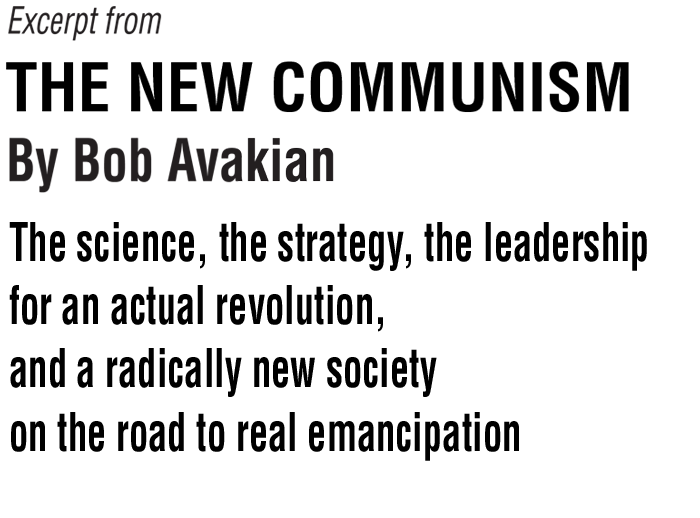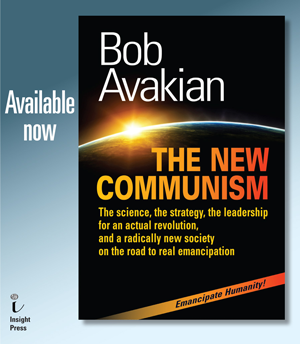
Editors' note: The following is an excerpt from the new work by Bob Avakian, THE NEW COMMUNISM. In addition to excerpts already posted on revcom.us, we will be running further excerpts from time to time on both revcom.us and in Revolution newspaper. These excerpts should serve as encouragement and inspiration for people to get into the work as a whole, which is available as a book from Insight Press. An updated pre-publication PDF of this major work—now including the appendices—is available here.
This excerpt comes from the section titled "IV. The Leadership We Need."
Excerpt from the section:
Statesmen, and Strategic Commanders
In moving toward a conclusion, I want to come back to this point about “statesmen,” and strategic commanders of the revolution. What does this mean? Well, there are different dimensions to this. Most basically, it means grasping, applying, and contributing to the development of, the theory and strategic approach for communist revolution; that’s the most basic thing it means to be a strategic commander of the revolution. It means you understand your role, and act, as an overall leader of the revolution—whatever your place or position is within the revolution, or within the vanguard party of the revolution, you think and act, in the appropriate ways, as someone who is contributing to the overall leadership of this revolution, as opposed to just being a cog in the machine and making an absolute out of a division of labor.
A party needs a division of labor, it needs people doing different tasks and working on different fronts of the overall revolutionary movement. It also has, and needs to have, a structure which—no apologies to “Occupy”—is not just horizontal, but is also vertical. In other words, you have people on different levels of the Party who correspondingly have more or less responsibility for the whole thing. And that goes along with the epistemological dimension to this because, without being mechanical or rigid about this, there is, there should be, a general correspondence between the level of the Party that you’re on and your ability to contribute, and especially to lead—both in the sense of the “raw material” that you have to work with (that is, the information that is coming to you, through Party channels, as well as other sources) and in the sense of your ability to synthesize things and develop line and policy. So, if you’re in the very top leadership of the Party, you have a lot more “raw material” that’s feeding in from the world overall, as well as specifically from the work of the Party, from the different levels of the Party, and you have correspondingly more responsibility for synthesizing that into line—into theory, strategy, policy, and so on. But everybody at every level has the same fundamental responsibility, and should have the same orientation that they are responsible for the whole revolution. In that fundamental sense, it doesn’t matter what role you have in the overall division of labor. You might be working on a particular thing, such as Stop Patriarchy,69 but you’re not a “Stop Patriarchy communist.” You are a communist who might be working, primarily, in Stop Patriarchy, or SMIN (Stop Mass Incarceration Network),70 or other things. Your fundamental responsibility is to contribute as much as possible to working through all the contradictions that have to be fought through to advance on the road of revolution and get to the point where we can actually go all-out with a real chance of winning. This means thinking critically, and raising criticism, in the right spirit and in the right way, through the right channels, if you think things are off track or things are not being taken up which should be taken up. This same basic principle applies more broadly to people who are not yet in the Party but are moving through the “Ohio” as part of the broader movement for revolution: they should have the same fundamental orientation of contributing everything they can to the revolution, even though people who are part of the Party can approach this on a still higher level, as part of a more advanced collective organization and process.
The basic principle and fundamental orientation is this: Take responsibility for the revolution as a whole. This is what it means to be a strategic commander of the revolution.
69. Stop Patriarchy is a mass organization of women, and men, whose essential mission is indicated by its main slogan, “END PORNOGRAPHY AND PATRIARCHY: THE ENSLAVEMENT AND DEGRADATION OF WOMEN.” The RCP, which played a key role in the initiation of Stop Patriarchy, works to develop this organization as a powerful force in the fight against attacks on the right to abortion and birth control, and the sexual degradation and all-around oppression of women, and to build this struggle in a way that contributes to the revolution that is needed to put an end to this, and to all, oppression. Information on Stop Patriarchy is available at StopPatriarchy.org, and also revcom.us. [back]
70. Stop Mass Incarceration Network (SMIN) is a mass initiative in which the RCP has played an initiating and leading role. SMIN has been deeply engaged in the struggle against mass incarceration and police terror and murder, as well as having been an initiator of RiseUpOctober. Information on SMIN is available at stopmassincarceration.net, and also revcom.us. [back]
Contents
Publisher's Note
Introduction and Orientation
Foolish Victims of Deceit, and Self-Deceit
Part I. Method and Approach, Communism as a Science
Materialism vs. Idealism
Dialectical Materialism
Through Which Mode of Production
The Basic Contradictions and Dynamics of Capitalism
The New Synthesis of Communism
The Basis for Revolution
Epistemology and Morality, Objective Truth and Relativist Nonsense
Self and a “Consumerist” Approach to Ideas
What Is Your Life Going to Be About?—Raising People’s Sights
Part II. Socialism and the Advance to Communism:
A Radically Different Way the World Could Be, A Road to Real Emancipation
The “4 Alls”
Beyond the Narrow Horizon of Bourgeois Right
Socialism as an Economic System and a Political System—And a Transition to Communism
Internationalism
Abundance, Revolution, and the Advance to Communism—A Dialectical Materialist Understanding
The Importance of the “Parachute Point”—Even Now, and Even More With An Actual Revolution
The Constitution for the New Socialist Republic in North America—
Solid Core with a Lot of Elasticity on the Basis of the Solid Core
Emancipators of Humanity
Part III. The Strategic Approach to An Actual Revolution
One Overall Strategic Approach
Hastening While Awaiting
Forces For Revolution
Separation of the Communist Movement from the Labor Movement, Driving Forces for Revolution
National Liberation and Proletarian Revolution
The Strategic Importance of the Struggle for the Emancipation of Women
The United Front under the Leadership of the Proletariat
Youth, Students and the Intelligentsia
Struggling Against Petit Bourgeois Modes of Thinking, While Maintaining the Correct Strategic Orientation
The “Two Maximizings”
The “5 Stops”
The Two Mainstays
Returning to "On the Possibility of Revolution"
Internationalism—Revolutionary Defeatism
Internationalism and an International Dimension
Internationalism—Bringing Forward Another Way
Popularizing the Strategy
Fundamental Orientation
Part IV. The Leadership We Need
The Decisive Role of Leadership
A Leading Core of Intellectuals—and the Contradictions Bound Up with This
Another Kind of “Pyramid”
The Cultural Revolution Within the RCP
The Need for Communists to Be Communists
A Fundamentally Antagonistic Relation—and the Crucial Implications of That
Strengthening the Party—Qualitatively as well as Quantitatively
Forms of Revolutionary Organization, and the “Ohio”
Statesmen, and Strategic Commanders
Methods of Leadership, the Science and the “Art” of Leadership
Working Back from “On the Possibility”—
Another Application of “Solid Core with a Lot of Elasticity on the Basis of the Solid Core”
Appendix 1:
The New Synthesis of Communism:
Fundamental Orientation, Method and Approach,
and Core Elements—An Outline
by Bob Avakian
Appendix 2:
Framework and Guidelines for Study and Discussion
Notes
Selected List of Works Cited
About the Author
 Download PDF of entire work
Download PDF of entire work